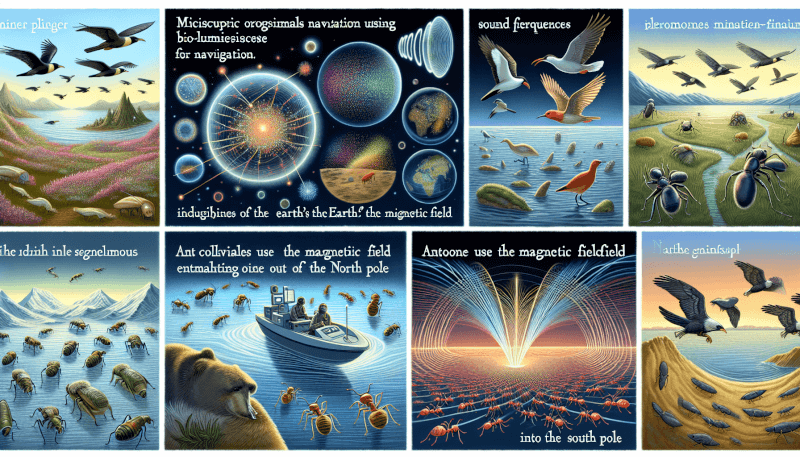Imagine a world without street signs or GPS systems to guide you on your way. It would be a chaotic mess of confusion and misdirection. Thankfully, we live in a time where navigation and signaling are seamlessly integrated into our everyday lives. However, have you ever wondered how these systems actually work? In this article, we will explore the fascinating world of navigation and signaling, uncovering the technology behind our ability to find our way and communicate effectively in today’s modern world. Get ready to embark on a journey of discovery as we navigate through the intricacies of this crucial aspect of our daily lives.
What is Navigation and Signaling?
Navigation and signaling are essential components of any journey, whether it be on land, sea, or in the air. These practices involve the ability to determine one’s location and course, as well as actively communicating or signaling with others. By utilizing various tools and techniques, navigation and signaling allow individuals to safely navigate through unfamiliar territories, communicate important information, and ultimately reach their intended destinations.
Definition
Navigation refers to the process of determining one’s position and direction relative to a given point or destination. It involves using methods such as celestial navigation, dead reckoning, and electronic navigation to plot a course and stay on track. Signaling, on the other hand, involves the use of visual, auditory, or electronic means to communicate important information, such as distress signals or location indicators, to others.
Importance
Navigation and signaling play a crucial role in various fields, including transportation, aviation, maritime operations, and even military applications. By accurately determining one’s position and effectively communicating with others, individuals and organizations can safely traverse unknown or challenging environments, avoid potential hazards, and ensure the efficient movement of people and goods.
Types of Navigation
Celestial Navigation
Celestial navigation relies on celestial bodies, such as the sun, moon, stars, and planets, to determine one’s position and direction. By measuring the altitude and azimuth of these celestial bodies and comparing them to known astronomical data, mariners and aviators can calculate their latitude and longitude and establish a reliable navigation reference point.
Dead Reckoning
Dead reckoning involves estimating one’s current position based on previously known positions and the course and speed at which the journey has been conducted. By continuously tracking distances and directions traveled, this technique allows for a general estimation of position even without external references. However, it is subject to cumulative errors and requires regular updates to maintain accuracy.
Electronic Navigation
In the modern age, electronic navigation has become increasingly prevalent. It relies on advanced technologies such as Global Positioning System (GPS), radar, and electronic charts to determine precise positions and navigate with accuracy. GPS, in particular, uses a network of satellites to triangulate positions on Earth, providing real-time location data to users.

Navigation Aids
Traditional Aids
Traditional navigation aids include tools and instruments that have been used for centuries to assist navigators in finding their way. One such aid is the compass, which utilizes the Earth’s magnetic field to indicate direction. By aligning itself with the magnetic North Pole, a compass provides a reliable reference for maintaining course headings.
Another traditional aid is the sextant, commonly used in celestial navigation. This handheld instrument measures the angle between celestial bodies and the horizon, allowing navigators to determine their latitude accurately.
Modern Aids
With the advancement of technology, modern navigation aids have emerged, enhancing navigational accuracy and efficiency. GPS, as mentioned earlier, is a significant modern aid that provides precise location data. Additionally, radar systems use radio waves to detect and track objects, providing navigators with information on the proximity of other vessels, landmasses, or obstacles.
Furthermore, electronic charts and navigation software have become invaluable tools for mariners and aviators. These digital maps can display information such as water depths, navigational marks, and hazards, making navigation more accessible and safer.
Navigation Instruments
Compass
The compass is one of the most fundamental instruments in navigation. It consists of a freely rotating magnetic needle that aligns itself with Earth’s magnetic field, always pointing towards the magnetic North Pole. By referencing the compass needle, navigators can maintain a consistent heading and determine relative directions.
Sextant
A sextant is a precision instrument used in celestial navigation to measure the angle between celestial bodies, such as the sun, moon, or stars, and the observer’s visible horizon. By recording these angles and using trigonometric calculations, navigators can determine their latitude accurately.
GPS
The Global Positioning System (GPS) is a constellation of satellites that provides real-time positioning and navigation data to GPS receivers on Earth. By receiving signals from multiple satellites and using trilateration, GPS receivers can calculate their precise latitude, longitude, and altitude, enabling accurate navigation.
Radar
Radar systems utilize radio waves to detect and track objects in their vicinity. These systems emit radio waves and measure the time it takes for the waves to bounce back after hitting objects. By analyzing the time delay and strength of these returning waves, radar systems can detect other vessels, obstacles, or landmasses, allowing for effective navigation and collision avoidance.

Communications Systems
Radio
Radio communication has revolutionized long-distance communication and plays a crucial role in navigation and signaling. It allows for real-time communication between vessels, air traffic control, and other navigational authorities. By using designated radio frequencies and protocols, navigators can exchange vital information, such as position, weather updates, and navigation instructions.
Satellite Communications
Satellite communications enable global communication coverage, even in remote or maritime regions beyond the reach of traditional communication infrastructure. Satellites in geostationary or low-earth orbit can facilitate voice, data, and internet communication, providing navigators with vital resources and enabling efficient communication during long journeys or in emergency situations.
Visual Signaling
Visual signaling involves using light or other visual means to communicate information over short distances. Techniques such as Morse code, semaphore, flares, and whistle signals have been historically used to convey messages in situations where verbal or radio communication is limited or unreliable. Visual signaling can be effective in maritime distress situations or when communicating essential information to nearby vessels or aircraft.
Signaling Techniques
Semaphore
Semaphore is a visual signaling system that utilizes a series of flags or paddles held in different positions to represent letters or numbers. By rapidly changing the positions of these flags or paddles, a semaphore operator can spell out words or convey messages over a long distance. Semaphore was commonly used in naval and military operations before the invention of radio communication.
Morse Code
Morse code is a communication system that uses combinations of long and short signals, usually represented by dots and dashes, to represent letters, numbers, and punctuation. It is primarily used for telegraphy and was instrumental in early long-distance communication. Even today, Morse code is still valuable in certain situations, such as radio communication in remote or emergency scenarios.
Flares
Flares are pyrotechnic devices that emit a bright, colorful light when ignited. They are commonly used in maritime distress situations to signal for help or indicate one’s position to nearby vessels or aircraft. By launching flares into the air, navigators can attract attention and communicate their need for assistance, especially when other communication methods are unavailable or unreliable.
Whistle Signals
Whistle signals are short, distinctive sound patterns produced by a whistle to convey specific messages or commands. They have been used in maritime operations, especially on ships and boats, to communicate essential information such as maneuvering instructions, warnings, or emergency signals. Whistle signals can be heard over long distances and are effective in situations with limited visibility or in noise-filled environments.

Military Applications
Tactical Navigation
In military operations, tactical navigation involves the use of specialized techniques and equipment to accurately navigate and maneuver through challenging terrains and combat zones. Military personnel utilize topographic maps, compasses, and advanced GPS systems to maintain situational awareness, plan routes, and coordinate movements with precision.
Battlefield Communication
Effective communication is paramount on the battlefield, where split-second decisions can mean the difference between success and failure. Military forces employ a range of communication systems, including encrypted radios, satellite communication terminals, and even visual signaling techniques, to ensure rapid and secure information exchange among units and command centers.
Signal Intelligence
Signal intelligence, often referred to as SIGINT, is a critical military discipline that involves intercepting, analyzing, and exploiting enemy communications and signaling. By collecting and decoding intercepted signals, military authorities can gather valuable intelligence on enemy troop movements, intentions, and potential threats. Signal intelligence plays a pivotal role in modern warfare, enabling military forces to stay one step ahead of their adversaries.
Navigational Challenges
Weather
Weather conditions can significantly impact navigation and signaling. Fog, heavy rain, and storms can reduce visibility, making it difficult to navigate and communicate effectively. Strong winds, rough seas, or icy conditions can create additional challenges when attempting to maintain course or execute signaling techniques. Navigators must be well-prepared and adapt to changing weather conditions to ensure safe passage and reliable communication.
Obstacles
Navigating around obstacles, such as rocks, reefs, or underwater hazards, requires careful planning and accurate positioning. Failing to navigate around these obstacles can lead to accidents or damage to vessels or aircraft. Signaling, on the other hand, may also be impeded by tall buildings, dense forests, or mountainous terrain, restricting visibility or obstructing signal transmission. Navigators must be vigilant and use appropriate tools and techniques to navigate safely and signal effectively in the presence of obstacles.
Navigational Errors
Navigational errors, including incorrect course plotting, misreading instruments, or GPS malfunctions, can result in significant deviations from the intended route or destination. These errors can lead to delays, danger, or even navigational emergencies. It is essential to maintain a steady vigilance, cross-verify information, and have backup systems or redundant procedures in place to minimize the risks associated with navigational errors.

Signal Codes and Protocols
International Maritime Signal Flags
International maritime signal flags are a set of flags, each representing a specific letter or message, used for communication between vessels at sea. By hoisting these flags in specific combinations, mariners can convey standardized messages, such as requests for assistance, navigational warnings, or informational signals. The use of international maritime signal flags ensures clear and concise communication, especially in situations where language barriers or radio communication may pose challenges.
Radio Communication Protocols
Radio communication protocols provide a structured and efficient means of communication between vessels, aircraft, and land-based control centers. These protocols dictate a standardized language, terminology, and procedures for transmitting and receiving messages, ensuring clarity, brevity, and accuracy. Following established communication protocols reduces the potential for misinterpretation or confusion, enabling smooth and effective communication between different parties.
The Future of Navigation and Signaling
Advancements in Technology
As technology continues to advance, navigation and signaling are poised to benefit from further innovation. Improvements in GPS technology may lead to increased accuracy and faster positioning updates. Additionally, the integration of satellite-based navigation systems with augmented reality and virtual reality technologies may enhance situational awareness and provide more intuitive navigation displays.
Integration with Artificial Intelligence
Artificial intelligence (AI) has the potential to revolutionize navigation and signaling by analyzing vast amounts of data, predicting weather patterns, optimizing routes, and assisting in decision-making processes. AI-powered systems could enhance navigation in challenging environments, such as densely populated areas or complex waterways, by guiding vessels or aircraft through optimal paths and providing real-time updates on potential obstacles or hazards.
In conclusion, navigation and signaling form the backbone of safe and efficient travel across various domains. Whether it be finding your way on a hike, directing traffic at an airport, or coordinating military operations, these practices are crucial for maintaining situational awareness, ensuring effective communication, and reaching your intended destination. With the rapid pace of technological advancements, navigation and signaling are set to evolve further, bringing new tools, methods, and possibilities to enhance our ability to navigate and communicate in an increasingly interconnected world.



